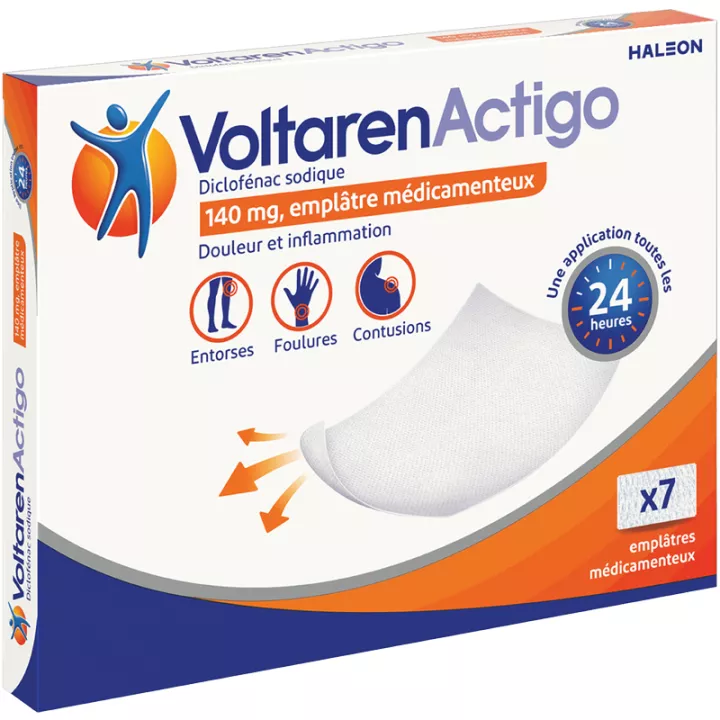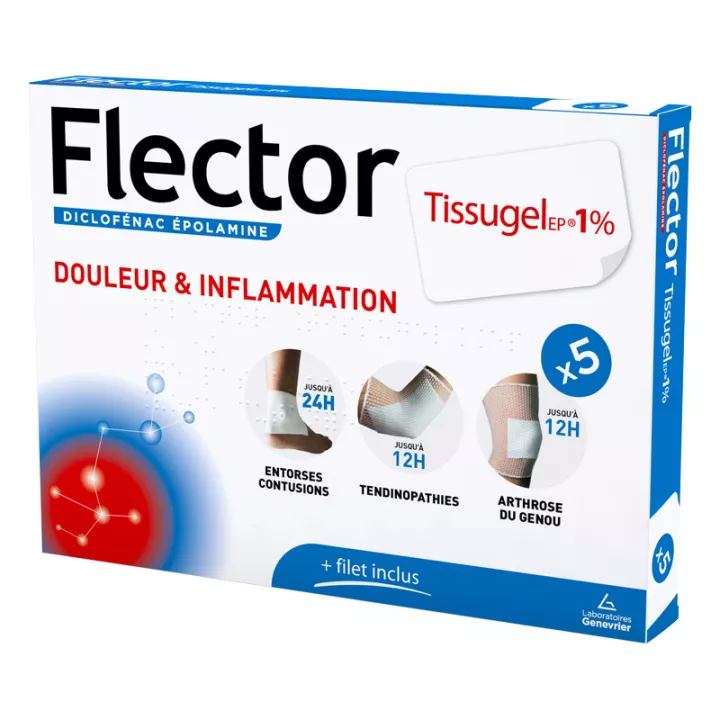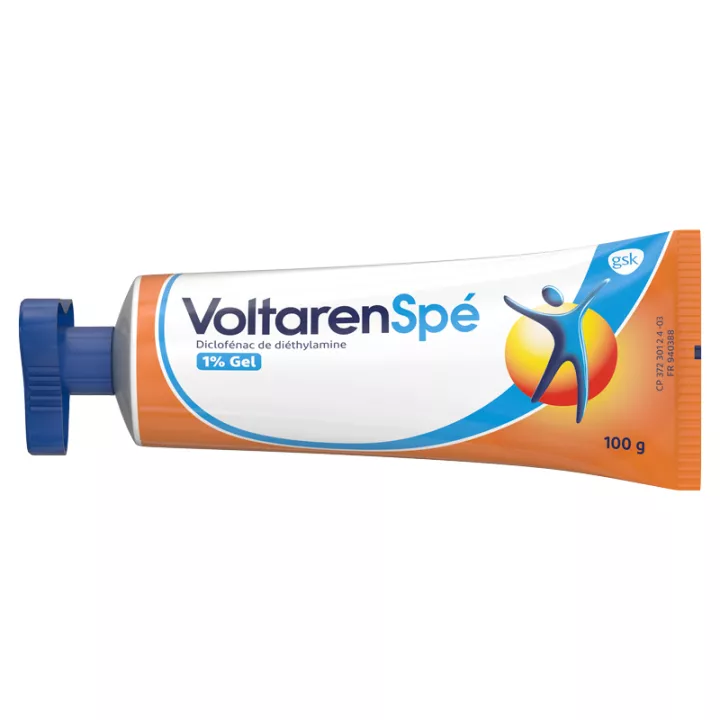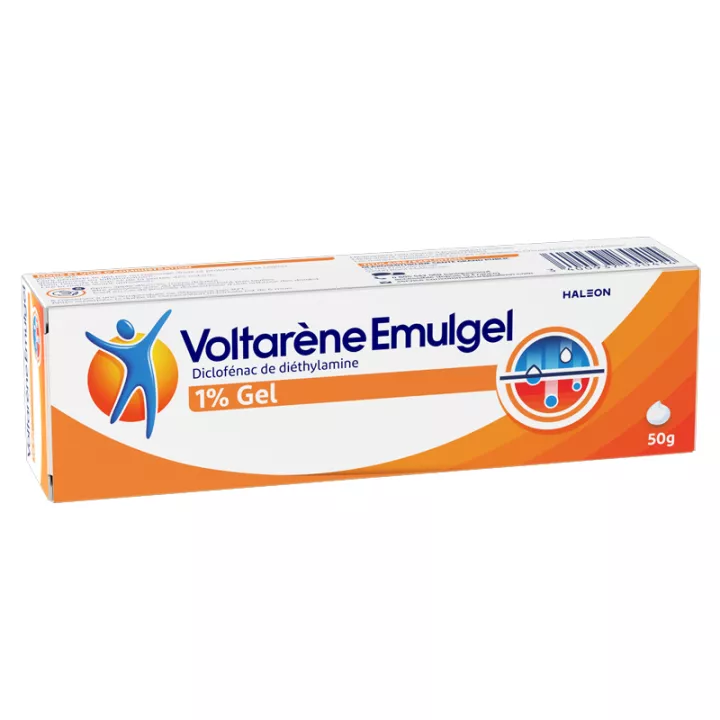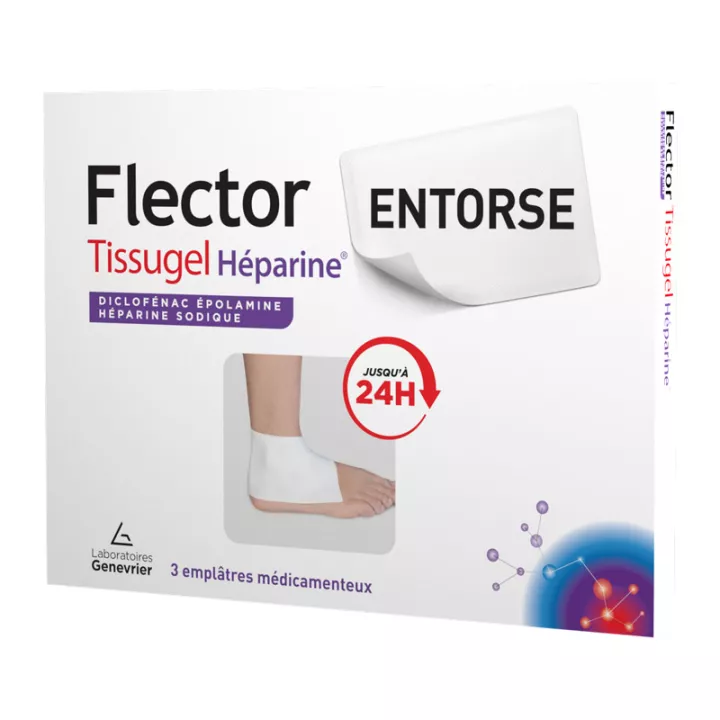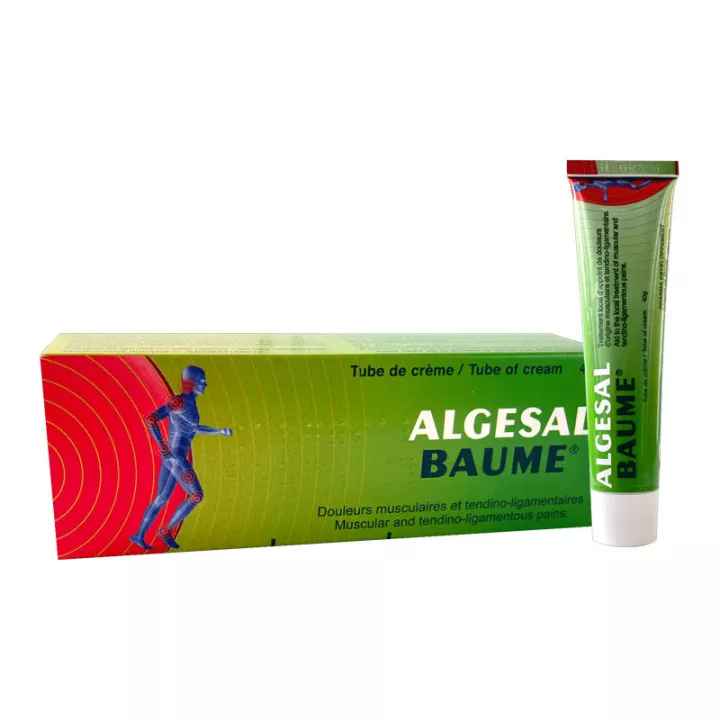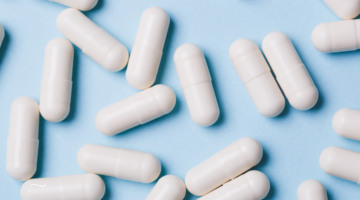NOTICE
ANSM - Updated on: 08/01/2016
Name of the medicinal product
VOLTARENPLAST 1%, medicated plaster
Diclofenac sodium
framed
Please read this leaflet carefully before you start using this medicine because it contains important information for you.
You should always use this medication exactly as prescribed in this leaflet or by your doctor or pharmacist.
· Keep this leaflet, you may need to read it again.
· Ask your pharmacist for advice or information.
· If you experience any of the side effects, talk to your doctor or pharmacist. This also applies to any side effects not mentioned in this leaflet. See section 4.
· You should contact your doctor if you experience no improvement or feel less well after 3 days.
What is in this leaflet?
1. What is VOLTARENPLAST 1%, medicated plaster and in which cases it is used?
2. What should I know before using VOLTARENPLAST 1%, medicated plaster ?
3. How to use VOLTARENPLAST 1%, medicated plaster ?
4. What are the possible side effects?
5. How to store VOLTARENPLAST 1%, medicated plaster ?
6. Package contents and other information.
1. WHAT VOLTARENPLAST 1%, medicated plaster AND WHAT IT IS USED FOR?
VOLTARENPLAST 1%, medicated plaster is a medicine that relieves pain. It is part of the class of non-steroidal anti-inflammatory drugs (NSAIDs).
VOLTARENPLAST 1%, medicated plaster is used in local treatment of short duration in case of painful benign trauma: strains, sprains or contusions.
For dermal application only.
2. BEFORE YOU USE VOLTARENPLAST 1%, medicated plaster?
Never use VOLTARENPLAST 1%, medicated plaster:
· if you are allergic to diclofenac, propylene glycol, butylhydroxytoluene or any of the other ingredients of this medication,
· if you are allergic to other non-steroidal anti-inflammatory drugs (NSAIDs), such as acetylsalicylic acid or ibuprofen,
· in the event of a history of asthma, skin reaction or swelling inside the nose causing irritation following acetylsalicylic acid or other NSAIDs,
· if you are suffering from an evolving digestive ulcer,
· on cutaneous wounds regardless of the wound (eg abrasions, cuts, burns), exudative dermatitis, infected skin lesions or lesions of eczema,
· during the last three months of pregnancy,
· in children and adolescents under 16 years of age.
Warnings and Precautions
Talk to your doctor or pharmacist before using VOLTARENPLAST 1%, medicated plaster
· If you have or have been diagnosed with asthma or allergies, use of this medication may cause a bronchial spasm (bronchospasm) that can cause breathing difficulties.
· The appearance of a rash after application requires immediate cessation of treatment.
· in case of kidney, heart or liver disease, history of gastrointestinal ulcer disease, intestinal inflammatory disease or digestive bleeding.
The occurrence of adverse reactions can be minimized by using the lowest possible dose for the shortest possible treatment time necessary to relieve symptoms.
IMPORTANT PRECAUTIONS:
· If symptoms persist beyond 3 days, a physician should be consulted.
· Never apply the plaster to the eyes or mucous membranes and avoid contact with eyes and mucous membranes.
· VOLTARENPLAST 1%, medicated plaster should be applied to an intact, healthy skin and should not be applied to a wound or open wound.
· Do not use the plaster under occlusive dressing.
· VOLTARENPLAST 1%, medicated plaster should be used with caution in elderly patients who are more prone to adverse effects.
After removing the plaster, avoid exposing the treated area to sunlight or sunshine for about one day to reduce any risk of photosensitivity.
Do not use any medicinal product containing diclofenac or other NSAIDs, either orally or by mouth, at the same time.
Other medicines and VOLTARENPLAST 1%, medicated plaster
Inform your doctor or pharmacist if you are using, have recently used or could use any other medicines.
Under normal conditions of use of VOLTARENPLAST 1%, medicated plaster, the amount of diclofenac passing through the blood is very low, so the interactions described for oral diclofenac are unlikely.
Pregnancy, breast-feeding and fertility
If you are pregnant or breastfeeding, think you may be pregnant or plan a pregnancy, ask your doctor for advice or pharmacist before taking this medication.
Pregnancy Although rare, abnormalities have been reported in infants whose mothers took NSAIDs during pregnancy. During the first 6 months of pregnancy, VOLTARENPLAST 1%, medicated plaster can only be used on the advice of your doctor.
During the last three months of pregnancy, VOLTARENPLAST 1% should not be used as a medicated plaster because of the risk of increased severe consequences for the mother and child ( see "Never use VOLTARENPLAST 1 %, medicated plaster ") .
Fertility
The use of VOLTARENPLAST 1%, medicated plaster is not recommended for women wishing to conceive a child, having difficulty conceiving a child or being investigated to look for a cause of infertility.
feeding
Ask your doctor or pharmacist for advice before taking any medicine.
Diclofenac passes in very small quantities into breast milk. As no adverse reactions have been reported to the infant, it is generally not necessary to suspend breast-feeding during short-term use. VOLTARENPLAST 1%, medicated plaster should never be applied directly on the breasts.
Sport
Not applicable.
Driving and using machines
No effect of VOLTARENPLAST 1%, medicated plaster on the ability to drive vehicles and use machines is expected or only a negligible effect.
VOLTARENPLAST 1%, medicated plaster contains propylene glycol and butylhydroxytoluene.
Propylene glycol (E1520) may cause skin irritation.
Butylhydroxytoluene (E321) and may cause local skin reactions (eg eczema) or irritation of the eyes and mucous membranes.
3. HOW TO USE VOLTARENPLAST 1%, medicated plaster?
Always use this medication exactly as prescribed by your doctor or pharmacist. Check with your doctor or pharmacist if in doubt.
The recommended dose is:
adults
Apply an analgesic patch on the painful area twice a day (morning and evening). The maximum total dose that can be used is two plasters per day, even if there is more than one trauma to be treated. Do not treat more than one painful area at a time.
Children and adolescents under 16 years of age
Due to the absence of specific studies, VOLTARENPLAST 1%, medicated plaster should not be used in children and adolescents under 16 years of age.
The elderly
This drug should be used with caution in elderly patients who are more prone to adverse effects.
Patients with renal or hepatic impairment
This medication should be used with caution in patients with hepatic or renal impairment.
Administration mode
To be used exclusively in application on an intact and healthy skin. For application on the skin only. Do not apply when bathing or showering. Do not ingest!
1. Open the sachet containing the plaster, cutting along the dotted line.

2. Pull out a plaster and close the bag carefully by pressing the closure.

3. Remove the protective film from the adhesive surface of the plaster.

4. Then apply the plaster on the painful area.

If necessary, hold the analgesic patch using an elastic net.
Never cover the patch with a hermetic (occlusive) dressing.
Never cut the plaster.
After using the plaster, fold it in half with the adhesive side inward.
Duration of treatment
Based on limited data available, short-term treatment is recommended.
Never use VOLTARENPLAST 1%, medicated plaster for more than three days without consulting your doctor. There is no therapeutic benefit if you use VOLTARENPLAST for more than 7 days. .
In adolescents over 16 years of age and adults, if more than 7 days of use is required to relieve pain or symptoms worsen, parents of adolescents / patients are advised to seek medical attention.
If you used more VOLTARENPLAST 1%, medicated plaster than you should:
Check with your doctor if any side effects occur after improper use of VOLTARENPLAST or after accidental overdose (eg in children). It will tell you what to do, depending on the severity of the poisoning.
If you forget to use VOLTARENPLAST 1%, medicated plaster:
Do not take a double dose to make up for a missed dose.
If you have any further questions on the use of this medication, ask your doctor or pharmacist.
4. WHAT ARE POSSIBLE SIDE EFFECTS?
Like all medicines, VOLTARENPLAST 1%, medicated plaster can cause side effects, but they do not happen systematically in everyone.
Immediately consult your doctor and stop using the plaster if you experience any of the following: Rash with itching (hives), swelling of the hands, feet, ankles, face, lips, mouth or throat; difficulty breathing; decreased blood pressure or fatigue.
Possible side effects include:
Common (may affect up to 1 in 10 patients): skin reactions at the site of application, redness of the skin, eczema, inflammatory skin redness (including contact dermatitis and allergic), swelling of the skin, itching and burning sensations,
Uncommon (may affect up to 1 in 100 patients): generalized skin redness, hypersensitivity reactions (including urticaria), swelling of the skin and mucous membranes, and generalized allergic reactions.
Rare (can affect up to 1 in 1000 treated patients): Blisters, dry skin.
Very rare (can affect up to one in 10,000 patients treated): Asthma, severe eczema, skin lesion with pustules, skin lesion with ulceration and sensitivity to skin light.
Unknown frequency (frequency impossible to evaluate with available data): hematoma at the application site.
Diclofenac in the blood and levels of diclofenac in the blood are also extremely low after dermal application compared to levels in the blood that are reached after oral diclofenac. The risk of adverse effects affecting the whole body (eg gastrointestinal, hepatic or renal disorders or difficulty breathing) is very low after a dermal application compared to the frequency of adverse effects associated with oral diclofenac . If diclofenac is used over an extended area of the skin or for a prolonged period of time, systemic adverse effects may occur.
If you notice any side effects not listed in this leaflet, or if any of the side effects gets serious, tell your doctor or pharmacist
Declaration of side effects
If you experience any side effects, talk to your doctor or pharmacist. This also applies to any side effects not mentioned in this leaflet. You can also report adverse reactions directly via the national reporting system: National Agency for the Safety of Medicines and Health Products (ANSM) and network of Regional Centers of Pharmacovigilance - Website: www.ansm.sante.fr
By reporting adverse reactions, you are helping to provide more information about the safety of the drug.
5. HOW TO STORE VOLTARENPLAST 1%, medicated plaster?
Keep this medicine out of the reach and sight of children.
Do not use this medicine after the expiry date which is stated on the carton and sachet after EXP. The expiry date refers to the last day of that month.
Store at a temperature not exceeding 25ºC.
Store in the original package in order to protect from dryness and light.
Keep the sachet tightly closed to prevent drying out.
The medication is preserved 4 months after the opening of a sachet.
Do not throw any medicines into drains or rubbish. Ask your pharmacist to remove any medications you are no longer using. These measures will help protect the environment.
6. PACKAGE CONTENTS AND OTHER INFORMATION
What VOLTARENPLAST 1% contains, medicated plaster
· The active substance is:
Diclofenac sodium ................................................ .................................................. ...... 140 mg
For a medicated plaster.
· The other components are:
Glycerol, propylene glycol (E1520), diisopropyl adipate, crystallizable liquid sorbitol (E420), sodium carmellose, sodium polyacrylate, butyl methacrylate basic copolymer, disodium edetate, anhydrous sodium sulfite (E221), butylhydroxytoluene sulfate of aluminum and potassium, anhydrous colloidal silica, light (natural) kaolin, macrogol lauryl ether, levomenthol, tartaric acid, purified water.
What is VOLTARENPLAST 1%, medicated plaster and contents of the pack
VOLTARENPLAST is a plaster measuring 10 cm by 14 cm, with a uniform layer of white to light brown paste spread on a nonwoven backing and a detachable protective film.
Boxes of 2, 5, 10 or 14 plasters in resealable pouches containing 2 or 5 plasters.
Not all pack sizes may be marketed.
Marketing Authorization Holder
GLAXOSMITHKLINE HEALTH GRAND PUBLIC
100, ROUTE DE VERSAILLES
CS 80001
78164 MARLY-LE-ROI CEDEX
Marketing Authorization Operator
GLAXOSMITHKLINE HEALTH GRAND PUBLIC
100, ROUTE DE VERSAILLES
CS 80001
78164 MARLY-LE-ROI CEDEX
Maker
MERCKLE GMBH
LUDWIG-MERCKLE-STRASSE 3
89143 BLAUBEUREN
GERMANY
OR
TEVA OPERATIONS POLAND SP ZOO
UL. MOGIMSKA 80
31-546 KRAKOW
POLAND
OR
SOFARIMEX-INDUSTRIA QUIMICA E FARMACEUTICA SA
AV. DAS INDUSTRIAS
ALTO DE COLARIDE / ALGUALVA
2735-213 CACEM
PORTUGAL
OR
MEPHA PHARMA GMBH
MARIE-CURIE-STRASSE 8 - ROOM 1.28
79539 LORRACH
GERMANY
OR
NOVARTIS FAMILY HEALTH
10 RUE LOUIS BLERIOT
92500 RUEIL MALMAISON
Names of the medicinal product in the Member States of the European Economic Area
This medicinal product is authorized in the Member States of the European Economic Area under the following names: In accordance with the regulations in force.
The last date on which this leaflet was revised is:
[to be completed later by the holder]
Other
Detailed information on this medicine is available on the ANSM website (France).


